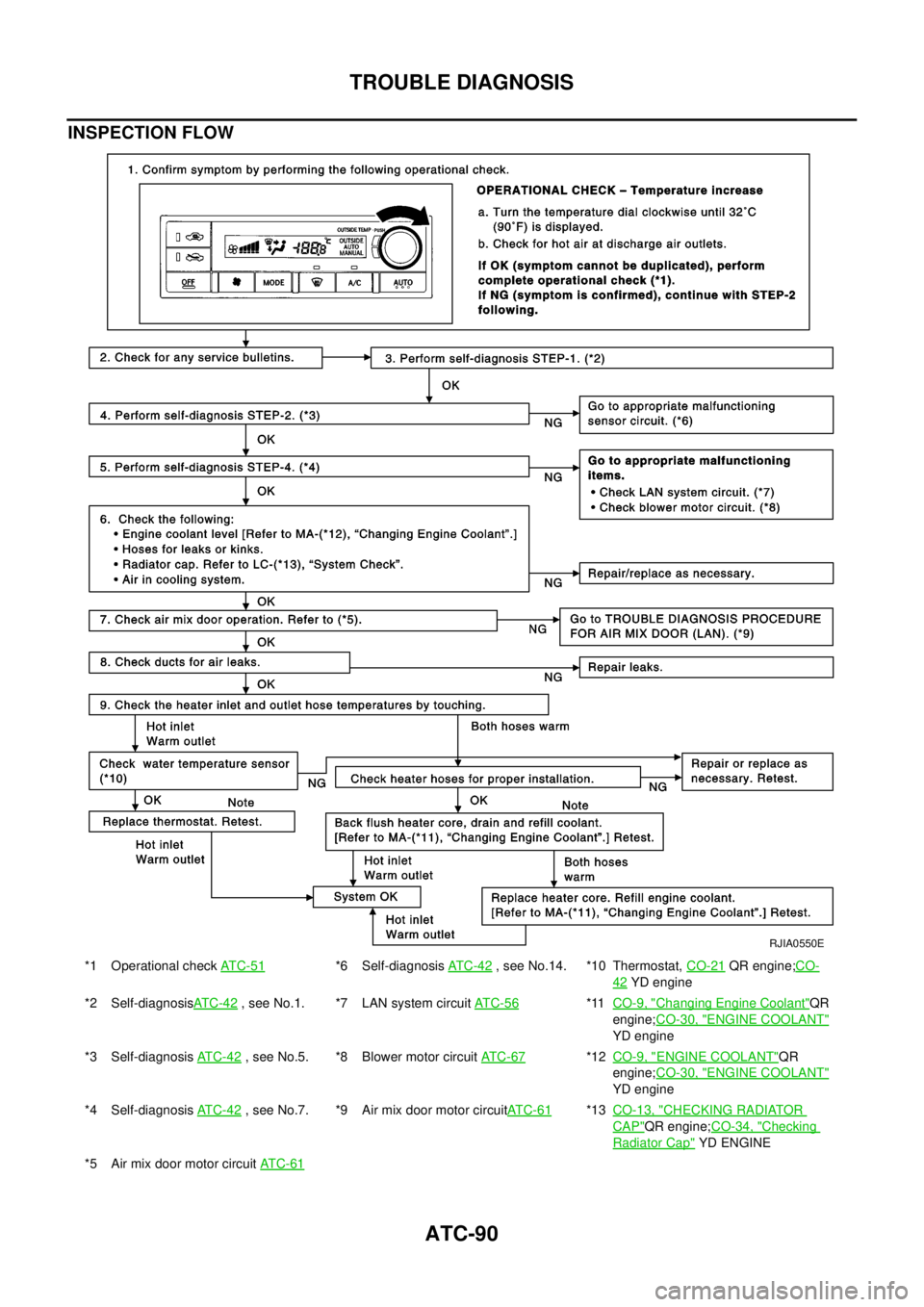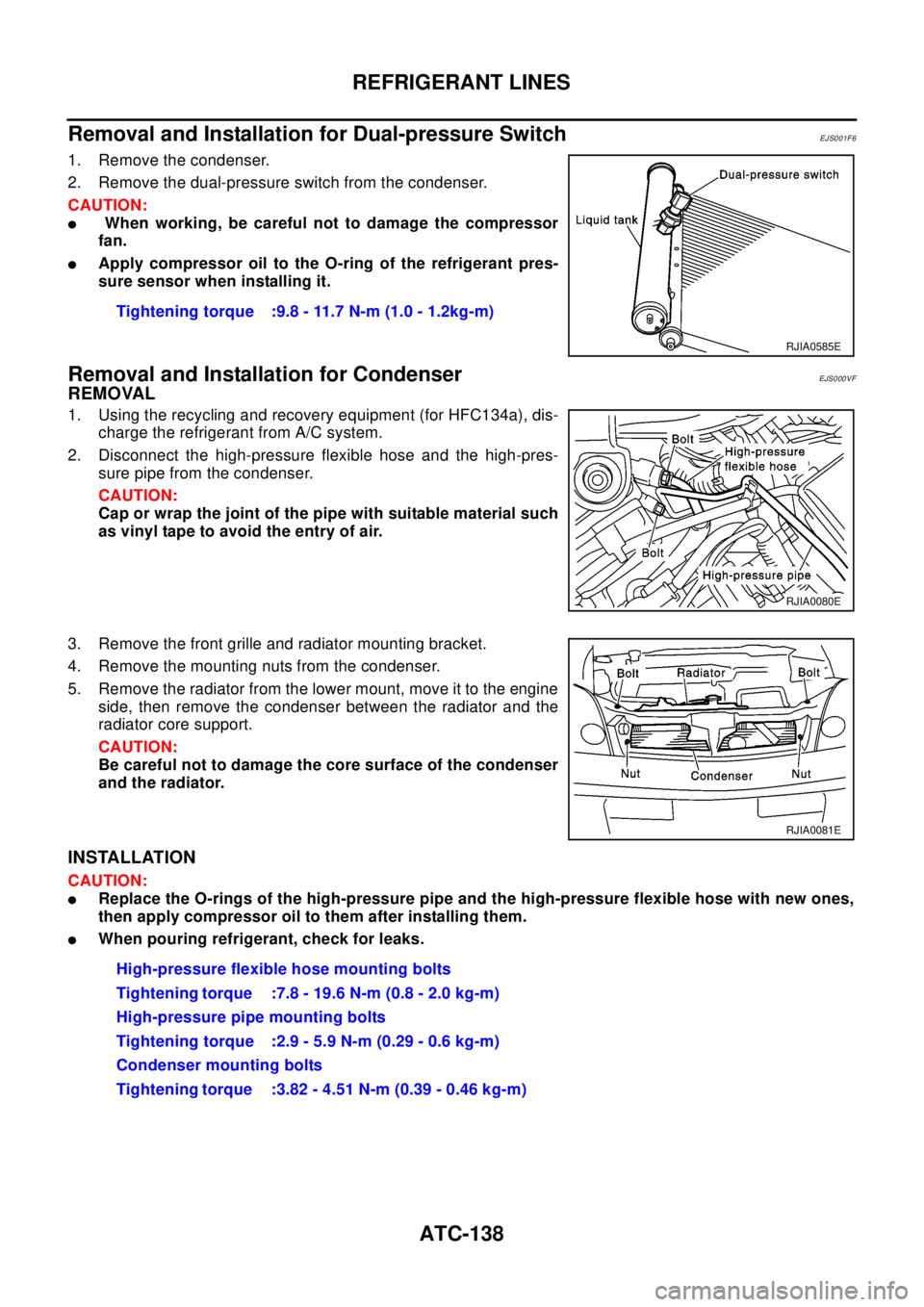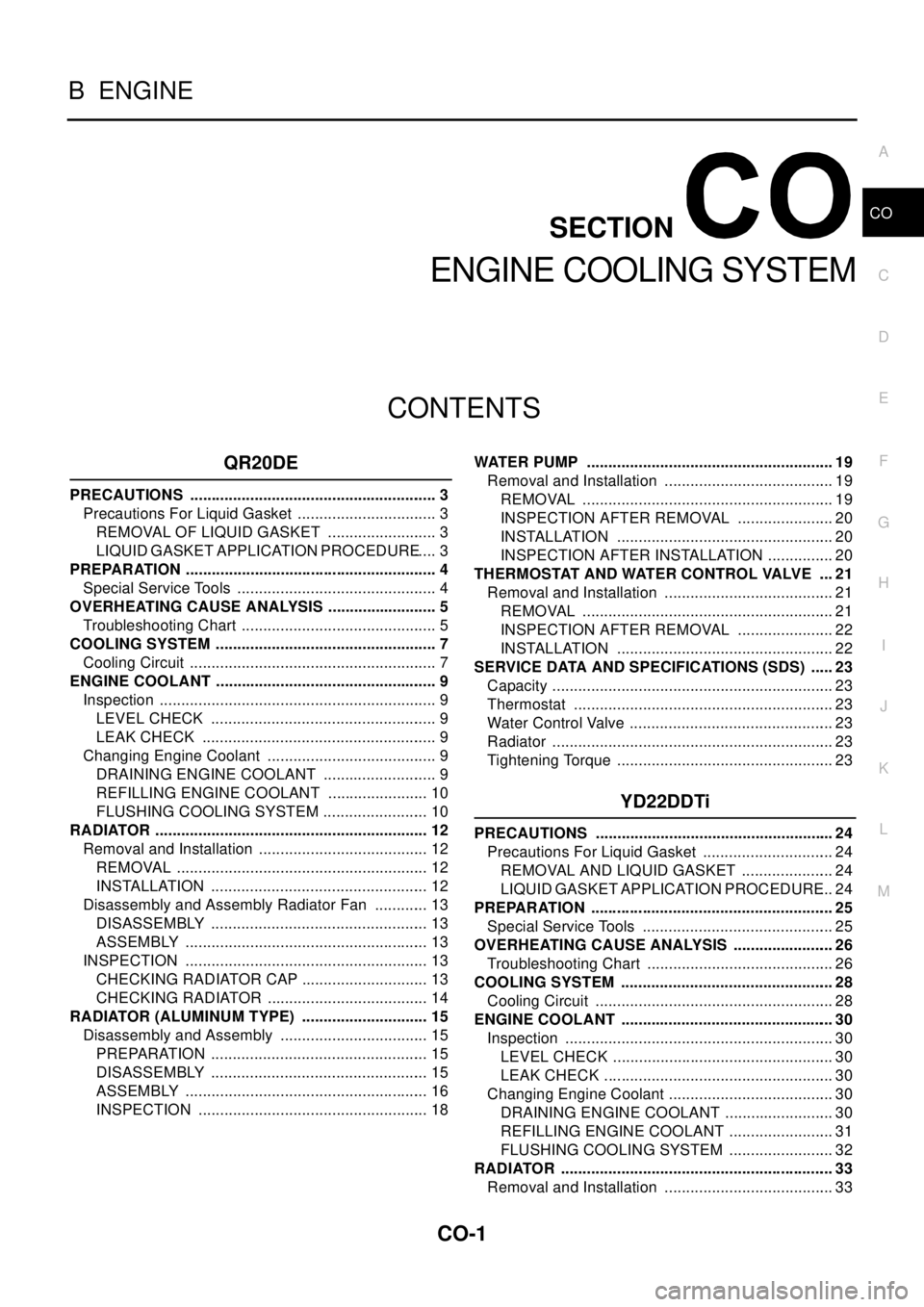2003 NISSAN X-TRAIL radiator cap
[x] Cancel search: radiator capPage 19 of 3066

A/T FLUID
AT-13
D
E
F
G
H
I
J
K
L
MA
B
AT
A/T FLUIDPFP:KLE40
Checking A/T FluidECS004Q7
1. Warm up engine.
2. Check for fluid leakage.
3. Before driving, fluid level can be checked at fluid temperatures
of 30 to 50°C (86 to 122°F) using “COLD” range on dipstick.
a. Park vehicle on level surface and set parking brake.
b. Start engine and move selector lever through each gear posi-
tion. Leave selector lever in “P” position.
c. Check fluid level with engine idling.
d. Remove dipstick and note reading. If level is at low side of either
range, and fluid to the charging pipe.
e. Re-insert dipstick into charging pipe as far as it will go.
f. Remove dipstick and note reading. If reading is at low side of range, add fluid to the charging pipe.
Do not overfill.
4. Drive vehicle for approximately 5 minutes in urban areas.
5. Re-check fluid level at fluid temperatures of 50 to 80°C (122 to 176°F) using “HOT” range on dipstick.
6. Check fluid condition.
lIf fluid is very dark or smells burned, refer to AT section for
checking operation of A/T. Flush cooling system after repair of
A/T.
lIf A/T fluid contains frictional material (clutches, bands, etc.),
replace radiator and flush cooler line using cleaning solvent
and compressed air after repair of A/T. Refer toCO-12,
"RADIATOR",CO-15, "RADIATOR (ALUMINUM TYPE)",,.
Changing A/T FluidECS004Q8
1. Warm up A/T fluid.
2. Stop engine.
3. Drain A/T fluid from drain plug and refill with new A/T fluid.
Always refill same volume with drained fluid.
4. Run engine at idle speed for five minutes.
5. Check fluid level and condition. Refer to “Checking A/T Fluid”. If fluid is still dirty, repeat steps 2 through 5.
SMA827CA
SMA853B
Fluid grade:
Genuine Nissan ATF or equivalent. Refer toMA-
17, "RECOMMENDED FLUIDS AND LUBRI-
CANTS".
Fluid capacity (With torque converter):
Approx. 8.0 (7.01 lmp qt)
Drain plug:
:29-39N·m(3.0-4.0kg-m,22-29ft-lb)
SMA027D
Page 668 of 3066

ATC-90
TROUBLE DIAGNOSIS
INSPECTION FLOW
*1 Operational checkAT C - 5 1*6 Self-diagnosisAT C -4 2, see No.14. *10 Thermostat,CO-21QR engine;CO-
42YD engine
*2 Self-diagnosisAT C -4 2
, see No.1. *7 LAN system circuitAT C - 5 6*11CO-9, "Changing Engine Coolant"QR
engine;CO-30, "
ENGINE COOLANT"
YD engine
*3 Self-diagnosisAT C - 4 2
, see No.5. *8 Blower motor circuitAT C - 6 7*12CO-9, "ENGINE COOLANT"QR
engine;CO-30, "
ENGINE COOLANT"
YD engine
*4 Self-diagnosisAT C - 4 2
, see No.7. *9 Air mix door motor circuitAT C - 6 1*13CO-13, "CHECKING RADIATOR
CAP"QR engine;CO-34, "Checking
Radiator Cap"YD ENGINE
*5 Air mix door motor circuitAT C - 6 1
RJIA0550E
Page 716 of 3066

ATC-138
REFRIGERANT LINES
Removal and Installation for Dual-pressure Switch
EJS001F6
1. Remove the condenser.
2. Remove the dual-pressure switch from the condenser.
CAUTION:
lWhen working, be careful not to damage the compressor
fan.
lApply compressor oil to the O-ring of the refrigerant pres-
sure sensor when installing it.
Removal and Installation for CondenserEJS000VF
REMOVAL
1. Using the recycling and recovery equipment (for HFC134a), dis-
charge the refrigerant from A/C system.
2. Disconnect the high-pressure flexible hose and the high-pres-
sure pipe from the condenser.
CAUTION:
Cap or wrap the joint of the pipe with suitable material such
as vinyl tape to avoid the entry of air.
3. Remove the front grille and radiator mounting bracket.
4. Remove the mounting nuts from the condenser.
5. Remove the radiator from the lower mount, move it to the engine
side, then remove the condenser between the radiator and the
radiator core support.
CAUTION:
Be careful not to damage the core surface of the condenser
and the radiator.
INSTALLATION
CAUTION:
lReplace the O-rings of the high-pressure pipe and the high-pressure flexible hose with new ones,
then apply compressor oil to them after installing them.
lWhen pouring refrigerant, check for leaks.Tightening torque :9.8 - 11.7 N-m (1.0 - 1.2kg-m)
RJIA0585E
RJIA0080E
RJIA0081E
High-pressure flexible hose mounting bolts
Tightening torque :7.8 - 19.6 N-m (0.8 - 2.0 kg-m)
High-pressure pipe mounting bolts
Tightening torque :2.9 - 5.9 N-m (0.29 - 0.6 kg-m)
Condenser mounting bolts
Tightening torque :3.82 - 4.51 N-m (0.39 - 0.46 kg-m)
Page 1011 of 3066

CO-1
ENGINE COOLING SYSTEM
B ENGINE
CONTENTS
C
D
E
F
G
H
I
J
K
L
M
SECTION
A
CO
ENGINE COOLING SYSTEM
QR20DE
PRECAUTIONS .......................................................... 3
Precautions For Liquid Gasket ................................. 3
REMOVAL OF LIQUID GASKET .......................... 3
LIQUID GASKET APPLICATION PROCEDURE..... 3
PREPARATION ........................................................... 4
Special Service Tools ............................................... 4
OVERHEATING CAUSE ANALYSIS .......................... 5
Troubleshooting Chart .............................................. 5
COOLING SYSTEM .................................................... 7
Cooling Circuit .......................................................... 7
ENGINE COOLANT .................................................... 9
Inspection ................................................................. 9
LEVEL CHECK ..................................................... 9
LEAK CHECK ....................................................... 9
Changing Engine Coolant ........................................ 9
DRAINING ENGINE COOLANT ........................... 9
REFILLING ENGINE COOLANT ........................ 10
FLUSHING COOLING SYSTEM ......................... 10
RADIATOR ................................................................ 12
Removal and Installation ........................................ 12
REMOVAL ........................................................... 12
INSTALLATION ................................................... 12
Disassembly and Assembly Radiator Fan ............. 13
DISASSEMBLY ................................................... 13
ASSEMBLY ......................................................... 13
INSPECTION ......................................................... 13
CHECKING RADIATOR CAP .............................. 13
CHECKING RADIATOR ...................................... 14
RADIATOR (ALUMINUM TYPE) .............................. 15
Disassembly and Assembly ................................... 15
PREPARATION ................................................... 15
DISASSEMBLY ................................................... 15
ASSEMBLY ......................................................... 16
INSPECTION ...................................................... 18WATER PUMP .......................................................... 19
Removal and Installation ........................................ 19
REMOVAL ........................................................... 19
INSPECTION AFTER REMOVAL ....................... 20
INSTALLATION ................................................... 20
INSPECTION AFTER INSTALLATION ................ 20
THERMOSTAT AND WATER CONTROL VALVE .... 21
Removal and Installation ........................................ 21
REMOVAL ........................................................... 21
INSPECTION AFTER REMOVAL ....................... 22
INSTALLATION ................................................... 22
SERVICE DATA AND SPECIFICATIONS (SDS) ...... 23
Capacity .................................................................. 23
Thermostat ............................................................. 23
Water Control Valve ................................................ 23
Radiator .................................................................. 23
Tightening Torque ................................................... 23
YD22DDTi
PRECAUTIONS ........................................................ 24
Precautions For Liquid Gasket ............................... 24
REMOVAL AND LIQUID GASKET ...................... 24
LIQUID GASKET APPLICATION PROCEDURE... 24
PREPARATION ......................................................... 25
Special Service Tools ............................................. 25
OVERHEATING CAUSE ANALYSIS ........................ 26
Troubleshooting Chart ............................................ 26
COOLING SYSTEM .................................................. 28
Cooling Circuit ........................................................ 28
ENGINE COOLANT .................................................. 30
Inspection ............................................................... 30
LEVEL CHECK .................................................... 30
LEAK CHECK ...................................................... 30
Changing Engine Coolant ....................................... 30
DRAINING ENGINE COOLANT .......................... 30
REFILLING ENGINE COOLANT ......................... 31
FLUSHING COOLING SYSTEM ......................... 32
RADIATOR ................................................................ 33
Removal and Installation ........................................ 33
Page 1012 of 3066

CO-2
REMOVAL ........................................................... 33
INSTALLATION .................................................... 33
Disassembly and Assembly Radiator Fan .............. 34
DISASSEMBLY ................................................... 34
ASSEMBLY ......................................................... 34
Checking Radiator Cap .......................................... 34
Checking Radiator .................................................. 35
RADIATOR (ALLUMINUM TYPE) ............................. 36
Disassembly and Assembly .................................... 36
PREPARATION ................................................... 36
DISASSEMBLY ................................................... 36
ASSEMBLY ......................................................... 37
INSPECTION ....................................................... 39WATER PUMP ...........................................................40
Removal and Installation .........................................40
REMOVAL ............................................................40
INSPECTION AFTER REMOVAL ........................40
INSTALLATION ....................................................40
INSPECTION AFTER INSTALLATION ................41
THERMOSTAT AND WATER PIPING .......................42
Removal and Installation .........................................42
REMOVAL ............................................................42
INSPECTION AFTER REMOVAL ........................43
INSTALLATION ....................................................43
SERVICE DATA AND SPECIFICATIONS (SDS) ......44
Standard and Limit ..................................................44
CAPACITY ...........................................................44
THERMOSTAT .....................................................44
RADIATOR ...........................................................44
Tightening Torque ...................................................44
Page 1014 of 3066
![NISSAN X-TRAIL 2003 Electronic Repair Manual CO-4
[QR20DE]
PREPARATION
PREPARATION
PFP:00002
Special Service ToolsEBS009SA
Tool number
Tool nameDescription
WS39930000
Tube presserPressing the tube of liquid gasket
EG17650301
Radiator cap tester NISSAN X-TRAIL 2003 Electronic Repair Manual CO-4
[QR20DE]
PREPARATION
PREPARATION
PFP:00002
Special Service ToolsEBS009SA
Tool number
Tool nameDescription
WS39930000
Tube presserPressing the tube of liquid gasket
EG17650301
Radiator cap tester](/manual-img/5/57402/w960_57402-1013.png)
CO-4
[QR20DE]
PREPARATION
PREPARATION
PFP:00002
Special Service ToolsEBS009SA
Tool number
Tool nameDescription
WS39930000
Tube presserPressing the tube of liquid gasket
EG17650301
Radiator cap tester adapterAdapting radiator cap tester to radiator filler
neck
a: 28 (1.10) dia.
b: 31.4 (1.236) dia.
c: 41.3 (1.626) dia.
Unit: mm (in)
KV99103510
Radiator plate pliers AInstalling radiator upper and lower tanks
KV99103520
Radiator plate pliers BRemoving radiator upper and lower tanks
S-NT052
S-NT564
S-NT224
S-NT225
Page 1015 of 3066
![NISSAN X-TRAIL 2003 Electronic Repair Manual OVERHEATING CAUSE ANALYSIS
CO-5
[QR20DE]
C
D
E
F
G
H
I
J
K
L
MA
CO
OVERHEATING CAUSE ANALYSISPFP:00012
Troubleshooting ChartEBS009SB
Symptom Check items
Cooling sys-
tem parts
malfunctionPoor heat tra NISSAN X-TRAIL 2003 Electronic Repair Manual OVERHEATING CAUSE ANALYSIS
CO-5
[QR20DE]
C
D
E
F
G
H
I
J
K
L
MA
CO
OVERHEATING CAUSE ANALYSISPFP:00012
Troubleshooting ChartEBS009SB
Symptom Check items
Cooling sys-
tem parts
malfunctionPoor heat tra](/manual-img/5/57402/w960_57402-1014.png)
OVERHEATING CAUSE ANALYSIS
CO-5
[QR20DE]
C
D
E
F
G
H
I
J
K
L
MA
CO
OVERHEATING CAUSE ANALYSISPFP:00012
Troubleshooting ChartEBS009SB
Symptom Check items
Cooling sys-
tem parts
malfunctionPoor heat transferWater pump malfunction Worn or loose drive belt
— Thermostat stuck closed —
Damaged finsDust contamination or
paper clogging
Mechanical damage
Clogged radiator cooling
tubeExcess foreign material
(rust, dirt, sand, etc.)
Reduced air flowCooling fan does not oper-
ate
—— High resistance to fan rota-
tion
Damaged fan blades
Damaged radiator shroud — — —
Improper coolant mixture
ratio———
Poor coolant quality — — —
Insufficient coolantCoolant leaksCooling hoseLoose clamp
Cracked hose
Water pump Poor sealing
Radiator capLoose
Poor sealing
RadiatorO-ring for damage, deterio-
ration or improper fitting
Cracked radiator tank
Cracked radiator core
Reservoir tank Cracked reservoir tank
Overflowing reservoir tankExhaust gas leaks into
cooling systemCylinder head deterioration
Cylinder head gasket dete-
rioration
Page 1019 of 3066
![NISSAN X-TRAIL 2003 Electronic Repair Manual ENGINE COOLANT
CO-9
[QR20DE]
C
D
E
F
G
H
I
J
K
L
MA
CO
ENGINE COOLANTPFP:KQ100
InspectionEBS009SD
LEVEL CHECK
lCheck if the reservoir tank coolant level within MIN to MAX when
engine is cool.
lAdjust NISSAN X-TRAIL 2003 Electronic Repair Manual ENGINE COOLANT
CO-9
[QR20DE]
C
D
E
F
G
H
I
J
K
L
MA
CO
ENGINE COOLANTPFP:KQ100
InspectionEBS009SD
LEVEL CHECK
lCheck if the reservoir tank coolant level within MIN to MAX when
engine is cool.
lAdjust](/manual-img/5/57402/w960_57402-1018.png)
ENGINE COOLANT
CO-9
[QR20DE]
C
D
E
F
G
H
I
J
K
L
MA
CO
ENGINE COOLANTPFP:KQ100
InspectionEBS009SD
LEVEL CHECK
lCheck if the reservoir tank coolant level within MIN to MAX when
engine is cool.
lAdjust coolant if too much or too little.
LEAK CHECK
lTo check for leakage, apply pressure to the cooling system with
atester.
WA RN ING:
Never remove the radiator cap when the engine is hot. Serious
burns could occur from high pressure coolant escaping from
the radiator.
CAUTION:
Higher pressure than specified may cause radiator damage.
Changing Engine CoolantEBS009SE
WA RN ING:
lTo avoid being scalded, never change the coolant when the engine is hot.
lWrap a thick cloth around cap and carefully remove the cap. First, turn the cap a quarter of a turn
to release built-up pressure. Then turn the cap all the way.
DRAINING ENGINE COOLANT
1. Open radiator drain plug at the bottom of radiator, and remove
radiator cap.
lBe careful not to allow coolant to contact drive belts.
SMA412B
Testing pressure
: 157 kPa (1.57bar 1.6 kg/cm2,23psi)
SLC134B
PBIC0236E